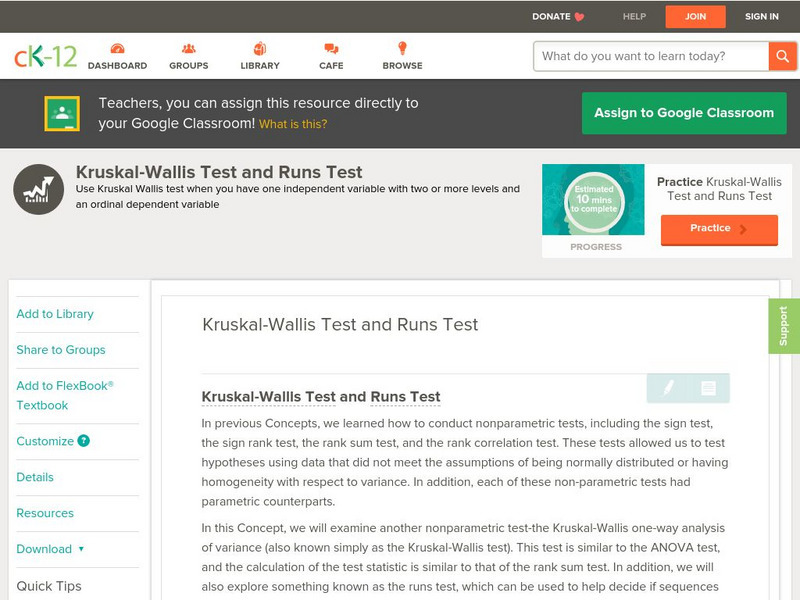Flipped Math
Experimental Design
Experimentally, come up with a study design. Learners hear about different types of study designs, observational studies, and experiments. They identify the subjects, response variable, treatment, and whether there was a cause and...
College Board
2005 AP® Statistics Free-Response Questions Form B
Here's another great way to learn from the past. Released free-response questions provide a look into how concepts measured on the 2005 AP® Statistics Exam on Form B. Teachers and pupils review questions that cover concepts such as...
College Board
2006 AP® Statistics Free-Response Questions Form B
Test a significant review of statistical questions. The resource provides pupils and teachers with insight into the way the exam assesses statistical concepts. Half of the released questions from the 2006 AP® Statistics Form B...
College Board
2000 AP® Statistics Free-Response Questions
A little communication goes a long way. Free-response questions from the 2000 AP® Statistics exam require pupils to communicate their results—not just perform calculations. The questions ask individuals to explain, discuss, and interpret...
College Board
2002 AP® Statistics Free-Response Questions
Statistically, prepared classes perform better. Teachers and pupils use the released 2002 AP® Statistics Free-Response questions to gain an understanding of how questions may be worded on the exam. Resources request that teachers put an...
College Board
2003 AP® Statistics Free-Response Questions
Hypothetically, knowing the structure of a test should help. Pupils use the released free-response questions from the 2003 AP® Statistics exam to become aware of the structure of questions on the test. Half the questions in the set...
College Board
2001 AP® Statistics Free-Response Questions
Develop a complete understanding of the course. Pupils and teachers use the six free-response questions to gather information about aspects of the AP® Statistics course. The resource and test section show how items cover the content. A...
College Board
2004 AP® Statistics Free-Response Questions
Provide some practice showing the work. Pupils work through six free-response questions that require them to show their work. They use their knowledge of statistics to develop solutions to problems within context. Scenarios range from...
College Board
2007 AP® Statistics Free-Response Questions
Knowing the questions ahead of time should be beneficial. Free-response questions released from the 2007 AP® Statistics tests provide teachers and pupils insight into the types of questions on the exam. The six open-ended questions show...
American Statistical Association
How Random Is the iPod’s Shuffle?
Shuffle the resource into your lesson repertoire. Scholars use randomly-generated iPod Shuffle playlists to develop ideas about randomness. They use a new set of playlists to confirm their ideas, and then decide whether the iPod randomly...
Shodor Education Foundation
Spread of Disease
Control the spread of a contagious disease. An applet allows pupils to run a simulation on the spread of a disease. Rules govern how the disease is spread and the length of time it takes to recover. Learners view the spread visually and...
Shodor Education Foundation
Shodor Interactivate: Marbles
Students learn about sampling with and without replacement by simulating marbles being drawn out of a bag. Settings can be altered to explore conditional probability.
Texas Instruments
Texas Instruments: Numb3 Rs: Random Thoughts
Based off of the hit television show NUMB3RS, this lesson shows students that random patterns often contain seemingly un-random subpatterns. Students experiment by flipping a coin a number of times and then looking for "runs" of heads or...
CK-12 Foundation
Ck 12: Statistics: Kruskal Wallis Test and Runs Test
[Free Registration/Login may be required to access all resource tools.] This Concept introduces the Kruskal Wallis test, as well as demonstrates ho to determine the randomness of a sample using the runs test.
Illustrative Mathematics
Illustrative Mathematics: S Ic School Advisory Panel
How do you choose the best sampling method for a specific task? This lesson asks the students to decide the best way out of four choices to select three students to serve on a school advisory panel. Students need to defend their choice....
Khan Academy
Khan Academy: Distributing Sites Randomly
This video [2:41] lesson, students learn about the best way to distribute points randomly. They can explore the interactive program used in the two video links provided.
Shodor Education Foundation
Shodor Interactivate: Marbles
Learn about sampling with and without replacement by randomly drawing marbles from a bag.
Shodor Education Foundation
Shodor Interactivate: Spread of Disease
Models how a population of susceptible, infected, and recovered people is affected by a disease.
Shodor Education Foundation
Shodor Interactivate: Directable Fire!!
Run a simulation of how a fire will spread through a stand of trees, learning about probability and chaos.
Shodor Education Foundation
Shodor Interactivate: Two Colors Applet
Choose one of three boxes and choose one ball from the box to look at conditional probabilities.
Other
Applied Thermodynamics: Entropy
Entropy is defined and discussed at this site from Applied Thermodynamics. The equation for this mathematical quantity is given and explained. Some unit information concerning entropy is provided.

















